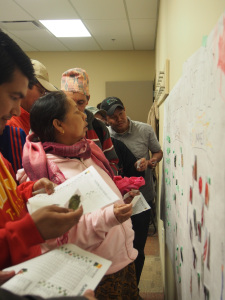After a long cold winter, the Our Food team is happy to be back in the gardening spirit. Even though we got a bit of a late start this year, it hasn’t prevented us from building garden skills in our partner communities.
Throughout the month of May we have been offering workshops on the Growing Calendar with our friends at the Bayers Westwood Family Resource Centre (BWFRC) and the Immigration Services Association of Nova Scotia (ISANS).
The basic idea of the Growing Calendar workshop is to help participants understand the various times to plant and harvest vegetables throughout a growing season. Many of our less experienced gardeners are uncertain about what to plant, when and how. Similarly, some of our very experienced New Canadian farmers who come from more hospitable climates are learning the specifics of growing food in Canada.
Inexperienced gardeners often hold the misconception that everything is planted all at once, and again everything is harvest all at once. We’ve also found that residents new to Canada, often plant things too early outside, or don’t know to start things indoors, as they’re used to better growing conditions than Halifax’s short and grey growing season. The workshop attempts to overcome some of these little mistakes by breaking down the growing season into several parts.
The workshop divides the growing season down into four simple planting periods: Winter; Spring; Summer; and Fall. We start by having a conversation about cold-hearty plants versus heat loving plants and the appropriate times to plant these varieties whether by seed or transplanted from indoors. I often use a great Growing Calendar developed by Peter from Home Harvest that has helpful illustrations as a tool to help participants think about the timing of their plantings.
In small groups participants are asked to pick a couple vegetables they like growing and to use the growing calendar to learn how and when to plant the vegetables they like. Are they planted indoors first and then transplanted in the summer? Are they direct seeded in the spring? Can they be planted again in the fall? This exercise helps participants engage with the calendar and get accustomed to using it.
To close the workshop, I usually have participants put their calendars away and together we plant what I call a “virtual garden.” To do this we place a large sheet of paper on the wall, with the four seasons mapped out. Each participant then reaches into the ‘seed bag’ and pulls out a handful of laminated images of veggies, which they’re then asked to ‘plant’ in the correct season. Once the busy gardeners have planted the virtual garden we discuss as a group and make any changes.
I find this workshop a great way to get gardeners thinking about gardening early, and to build a little excitement around growing food, even while the weather is poor. Participants get to make a few mistakes in their virtual garden that hopefully they can avoid once it comes to the real growing season. Now that Spring is finally arriving, we’re all very excited to apply what we’ve learned to our real gardens.
Author: Will Hill, Community Food Programmer. Ecology Action Centre
Contact: will@ecologyaction.ca
